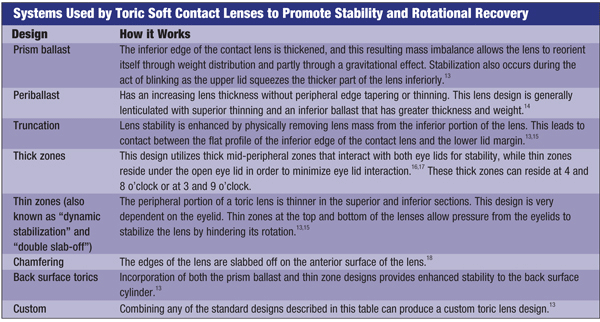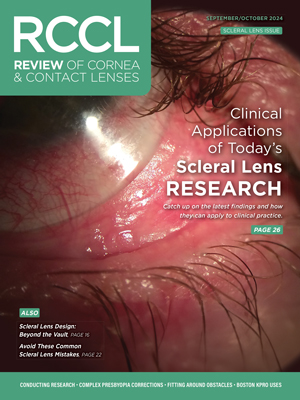All-day vision means having crisp, clear vision from waking until bedtime without experiencing fluctuations in visual clarity. For astigmats, achieving this goal is difficult, as they are sometimes treated with spherical lenses that do not correct astigmatism or prescribed toric lenses that do treat astigmatism, but can present their own challenges.
Spectacles or Contact Lenses
Spectacles offer consistent vision via a stable lens and a certain degree of eye protection for the patient. But, they can be cumbersome and fall short of providing total correction due to the lack of corrected peripheral vision. Contact lenses—soft spherical or toric—provide better overall visual acuity than spectacles.1,2 Contact lenses may be preferred by patients whose occupations or activities make spectacle wearing inconvenient. For younger patients, this modality has proven to have a positive impact on self-esteem and academic performance.2
In the Adolescent and Child Health Initiative to Encourage Vision Empowerment (ACHIEVE) study, where eight- to 11-year-old myopic children were assigned to wear spectacles or contact lenses, subjects wearing contact lenses reported higher self-ratings for physical appearance, athletic competence and social acceptance compared with those wearing spectacles.3 In this study, contact lens-wearing subjects also reported better vision-related quality of life compared to spectacle-wearing patients.4
Contact lenses can also be used to meet the vision correction needs of presbyopic patients who can benefit from the overall visual acuity and aesthetic considerations.5 In addition, multifocal contact lenses offer a single source of vision correction versus carrying multiple pairs of spectacles.
Despite their many benefits, contact lenses can be challenging. In general, they are more labor intensive than spectacles as they require diligent lens cleaning routines. For toric contact lenses in particular, price and fluctuations in vision can impact the satisfaction achieved with contact lens wear.1,2
When prescribing for astigmats, practitioners should ascertain whether spectacles or contact lenses best address the patient’s vision needs, although practitioners need not limit themselves to only one option when making their recommendation.

Spherical or Toric Lenses
Spherical contact lenses provide constant vision and have few, if any, associated rotational issues; however, they do not provide astigmatism correction.6,7 Many times astigmatic patients experience 20/20 or even 20/15 vision with spherical lenses while in the exam chair, but complain during their visit that their vision is not as sharp as before. Soft toric contact lenses do correct for astigmatism and come in a wide range of cylinder powers, starting as low as -0.75D. For toric contact lenses to correct astigmatism, the cylinder must not rotate far away from its starting position as cylinder correction decreases and as the cylinder axis misalignment increases.8 Earlier versions of soft toric contact lenses had a notorious reputation for being difficult to fit, but current toric lens options are now as easy to fit as sphericals.9 Practitioners that continue to prescribe spherical lenses for their astigmatic patients are likely not providing their patients with the best possible vision correction.
Advancements in Toric Lenses
Advances have been made in soft toric contact lens development. They are easier to fit and more reproducible, though lens rotation continues to be a challenge and can occur when patients blink or rub their eyes.10 As a result, there is an association of rotational issues attached to toric lens use.11 According to a recent survey, 87% of patients rub their eyes while wearing contact lenses, and these patients admitted to rubbing their eyes more than six times per day.11 About 89% of patients in this survey experienced fluctuating, changing or blurred vision after rubbing their eyes: 37% deemed it to be particularly bothersome when driving, 37% while looking at a computer screen and 27% said it was accompanied by eye itchiness.11
Another survey reported similar results with over 80% of patients suffering from rotational issues and over 25% experiencing rotation regularly or more frequently.12 Blurring of vision (58%), fluctuating vision with blinking (53%) and inconsistent vision (53%) after lens misorientation were reported.12 In this survey, soft toric contact lens users experienced, on average, more than three different rotational issues. The lens wear satisfaction was inversely proportional with the number of issues experienced.12 These two surveys demonstrate that rotational stability is problematic for astigmats, both in frequency of occurrence and in effect on their daily activities.
Stability Is Key
The ability of a lens to return to its primary gaze orientation following rotation is a major consideration when choosing toric lenses.10 Rotational recovery refers to how quickly a lens returns to the desired orientation following disruption, such as from eye rubbing.10 It is a critical element that can contribute to reduced or poor visual quality—problems that could lead to patient dissatisfaction and lens drop out.10,12 Therefore, it is important for practitioners to ask their patients if they are experiencing symptoms consistent with rotational issues so that corrective measures can be initiated.12
To increase stability and rotational recovery ability, soft toric contact lenses utilize several stabilization designs (see “Systems Used by Toric Soft Contact Lenses to Promote Stability and Rotational Recovery,” pg. 33). When choosing a lens, practitioners should be cognizant of the differences in stabilization designs so that they can choose a lens they feel will work best for their patients. For patients who are reporting difficulties with their contact lenses due to rotational recovery issues, refitting the patient with a lens with a different stabilization design may resolve the problem.
Fitting the Lens
When fitting a patient with a soft toric lens, manually rotate the lens and note the time it takes to reorient to the appropriate position.10 If reorientation takes too long, try a lens with a different lens stabilization design.10 Ensuring that the lens demonstrates rapid rotational recovery and excellent centration will provide the patient with more consistent clear vision—and may result in fewer patient refitting appointments in the future. When prescribing a soft toric contact lens, practitioners should consider the individual characteristics of the lens such as lens material. Silicone hydrogels allow a greater amount of oxygen permeability than hydrogels, but that does not automatically translate into increased patient comfort. Hydrogel lenses are less expensive than silicone hydrogel lenses and tend to attract fewer lipid deposits. Some patients adapt better to the less rigid hydrogel material.19 As reaction to the different lens materials varies from patient to patient, those unsuccessful with one material may experience improved results with another.
Making Comfort a Priority
Discomfort is a complaint that sometimes accompanies soft toric contact lens wear. Practitioners should be aware that the discomfort might actually be a reaction to inadequate or unstable vision. For instance, patients who spend many hours every day using a computer may feel discomfort at the end of the day, but their lack of comfort may also be the result of eye strain. Computer users who experience these symptoms while wearing their soft toric lenses should be advised to blink more often and consider the option of supplemental computer glasses, which can help alleviate accommodative stress.20 The use of rewetting drops should also be recommended. You can also attempt to simulate the normal distance between the patient and the computer to ascertain if the addition of plus power would alleviate the patient’s symptoms.
Lens awareness is another example of a typical patient complaint. If patients’ awareness of the lens is negatively impacting the patient’s satisfaction, consider refitting in a lens that utilizes a different material and stabilization design.
Options for Astigmats
Practitioners can employ several methods for achieving all-day vision for their astigmatic patients. But first, it is important to listen to patients, determine their needs and discuss the options that are available for meeting those needs. Spectacles can offer clear vision, but can be inconvenient for people with active lifestyles. Contact lenses can provide total vision correction and convenience; however, astigmats may be unaware that a soft contact lens option is available. Regardless of the modality, toric lenses provide better visual acuity than spherical lenses.7
When choosing the soft toric contact lens, rotational stability needs to be considered. Practitioners can reduce the incidence of rotational issues by prescribing a lens with demonstrated rotational recovery and stability. The goal of providing astigmats with consistent, all-day vision can be achieved when a properly fitted lens meets the patient’s vision needs. This will not only ensure patient satisfaction with their vision correction, but will also instill confidence in their practitioner’s abilities.
The author received editorial support for this article from BioScience Communications.
Katrina E. Parker, O.D. is a clinical associate professor and director of the Cornea and Contact Lens Service at the University of Houston College of Optometry. Her research includes clinical evaluation of novel contact lens designs and studying the impact of higher order aberrations on visual performance.
1. Gerber P. Prescribing soft toric lenses for the low astigmat. Contact Lens Forum. 1990;11:50-3.
2. Giannoni A, Walline J. Achieving vision correction…and more. CL Spectrum. 2010 Jan. Available at:
www.clspectrum.com/article.aspx?article=103781. (Accessed October 2010).
3.Walline JJ, Jones JA, Sinott L, et al. Randomized trial of the effect of contact lens wear on self-perception in children. Optom Vis Sci. 2009 Mar;86(3):222-32.
4. Rah MJ, Walline JJ, Jones-Jordan LA, et al. Vision specific quality of life of pediatric contact lens wearers. Optom Vis Sci. 2010 Aug;87(8):560-6.
5.Rajagopalan AS, Bennett ES, Lakshminarayanan V. Visual performance of subjects wearing presbyopic contact lenses. Optom Vis Sci. 2006 Aug;83(8):611-15.
6. Dabkowski JA, Roach MP, Begley CG. Soft toric versus spherical contact lenses in myopes with low astigmatism. Int Contact Lens Clin. 1992 Nov-Dec;19(11-12):252-6.
7. Richdale K, Berntsen DA, Mack CJ, et al. Visual acuity with spherical and toric soft contact lenses in low-to-moderate astigmatic eyes. Optom Vis Sci. 2007 Oct;84(10):969-75.
8. Snyder C. A review and discussion of crossed cylinder effects and over refractions with toric soft contact lenses. Int Contact Lens Clin. 1989 Apr;16(4):113-6.
9. Young G, McIlraith R, Hunt C. Clinical evaluation of factors affecting soft toric lens orientation. Optom Vis Sci. 2009 Nov;86(11):1259-66.
10. Cairns G. Rotational stability of silicone hydrogel toric contact lenses. Optician. 2010 Jan. Available at:
www.opticianonline.net/assets/getAsset.aspx?ItemID=3873. (Accessed October 2010).
11. Decision Analyst. Rub Your Eyes Research Report – Consumer Insights. 2010 May.
12. Decision Analyst. Toric Lens Rotational Recovery Issues – Consumer Insights. 2009 July.
13. Russell CH, Slonim CB. The correction of astigmatism with soft contact lenses. Ophthalmol Clin N Am. 2003 Sep;16(3):353-8.
14. Daniels K. Contact Lenses. Thorofare, N.J.: Slack Incorporated; 1999.
15. Lindsay R. Chapter 10: Soft toric lens design and fitting. In: Efron N, ed. Contact Lens Practice. Woburn, MA: Reed Educational and Professional Publishing Ltd; 2002.
16. Szczotka-Flynn LB. Toric CLs: the next phase of silicone hydrogel materials. CL Spectrum. 2005 Apr. Available at:
www.clspectrum.com/article.aspx?article=12775. (Accessed October 2010).
17. Watanabe RK. Soft toric contact lenses: today’s technology allows you to offer the best contact lens options for patients who have astigmatism. Optometric Management. 2008 Apr. Available at:
www.optometric.com/article.aspx?article=101613. (Accessed October 2010).
18. Remba MJ. Part II. Clinical evaluation of toric hydrophilic contact lenses. J Am Optom Assoc. 1981 Mar;52(3):211-21.
19. Rosenthal H. Silicone hydrogel contact lenses. Available at: www.eyecaresource.com/contact-lenses/silicone-hydrogel/. (Accessed January 2011).
20. American Optometric Association. Vision Discomfort Associated With Computer Vision Syndrome. Available at:
www.aoa.org/x9217.xml. (Accessed October 2010).


